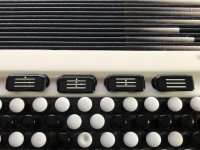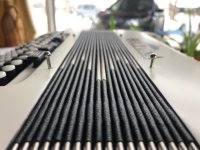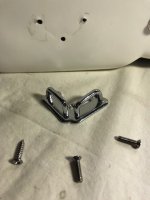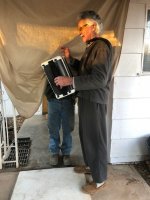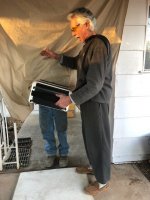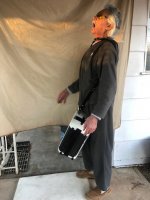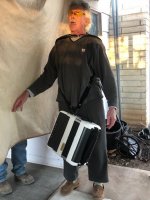Following is the email I recently sent to Beltuna Accordions describing my dismay regarding a recently purchased accordion. Included below are photos illustrating the several defects included with said accordion. The last 3 pics demonstrate what would have eventually happened had I not fortuitously discovered the incorrect screws attaching the upper shoulder strap bracket to the case.
START:
I recently purchased my second Beltuna accordion, a 200B Fly, CBA. The price was just south of $8,000.00 US, delivered. I was, of course, delighted to receive it several days later. A visual examination revealed an improper bass side register button. The box has 4 voices on the bass side with the common ledger lines with dots on the buttons, indicating the reed banks activated. The error was one of the buttons indicated a mute [Pic 1](No "dot" on right most button). That is, the lines were there, but no dots. I collect "errors", so I was secretly pleased that this was now one of my most valuable errors.
Further examination revealed a jammed register switch on the treble side. Being French, the switch is located on the backside of the button board. When placed into the case, the register switches rest directly against the case bottom. The resultant pressure bent a switch slider against the accordion body, jamming it in place. No big deal, I just bent it back into alignment and modified the case with a support pad that keeps the switch sliders suspended.
Pretty much every accordion I own has a bass strap that is too short for my big hand. I opened up the bass cover and added a strap extender in order to assure the adjuster knob would not separate from the strap stud. This is a common occurrence for me , and expected before my purchase. Making these "modifications" to my new accordion would, of course, preclude my returning it for a refund.
The box I ordered was configured in the French 3/3 system, and as such, didn't include bellows closure straps (sometimes I don't get French logic, (or lack thereof). I knew this beforehand, so had a set of bellows straps included with my order. When I went to install the straps, I noticed a misalignment of the bellows retention pin heads with the case. Upon extraction, I was annoyed to see that all of the pins were out of alignment (not at 90 degrees to the case)[Pic 2]. When partially removed they looked like a balding porcupine. I wasn't happy, but completed the strap install without incident.
While examining my handiwork, I noticed one of the top shoulder strap bracket screws (of which there are 3) was standing slightly proud. I grabbed a screwdriver to snug it up and was no longer secretly pleased, in fact I was REALLY PISSED OFF. The screw just spun easily, never gaining a hold on the case wood. The wood threads were stripped out. Now there were only 2 screws holding the bracket in place. If one was bad, how about the others? I put the driver to another screw and IT WAS THE SAME!!! The third screw tightened up as designed. I removed all 3 screws (with difficulty on the two loose screws, because they wouldn't bite into the wood) and discovered the two errant screws were MACHINE SCREWS!!!!! NOT WOOD SCREWS! [Pic 3] [Take extra special note, Beltuna].
For the uninitiated, wood screws have a thread that is larger in diameter than the hole they are inserted into, cutting threads into the host material as they screw in. Machine screws of the same size are manufactured to the diameter of the drilled hole, and retained by an appropriate size nut on the other end. The threads are completely different on the two screw types.
The bottom line is the upper, load carrying bracket, was attached with only ONE SCREW! It is obvious that the "engineers" at Beltuna felt 3 screws were required to safely carry the weight (18 lbs./8+ Kg) of the accordion. And I completely agree with them (the screws are only 1/2"/12mm long).
It was at this point that I knew I would NEVER buy another Beltuna product. When you think about it, if the one screw were to give way while wearing the accordion, the results would be severe. The accordion would plunge toward the ground [Pic 4], while at the same time the bracket, still attached to the shoulder straps, would snap upward, being stopped by my throat [Pic 5] (Adam's apple, by test). Anyone familiar with martial arts knows full well the vulnerability of the throat to an impact. You'll go straight to the ground! Imagine now, exiting a stage, walking down a short flight of stairs, bouncing as you (I) go, while gripping the banister when the one good screw lets go.... KILLER ACCORDION!
In addition to the karate chop to the neck, the plunging accordion would swing down and strike me right in the middle of the knees [Pic 6 & 7]. Another excellent martial arts target guaranteed to take an adversary down. BTW: the several other screws holding the lower bracket in place were of the correct type and holding securely.
There is NO EXCUSE for such a condition. Had I not elected to add the bellows straps, I never would have noticed the proud screw until it failed, with catastrophic consequences!
To put it in Italian, this sort of negligence is equivalent to Enzo selling Ferraris with several wheel nuts missing, and nobody noticing! They both can KILL YOU! Would Beltuna have come to my aid had the above situation occurred? I doubt it. No espeaki English.
Today is Monday, Dec. 6th, 2021. If this email is not adequately addressed before Friday, Dec 10th, 2021, I intend to post this communication on all three of the international Accordion Forums I am active on. As well as on any other forums I can find. I suspect the various Consumer Product Safety Agencies in America would like to know about it, as well. It is a disgrace that you let such a defective product leave your factory and put my well being at risk. Never again!
ENDING
Their response? "Send it back and we'll fix it."
As written above: Never again!
Press on,
Waldo
START:
I recently purchased my second Beltuna accordion, a 200B Fly, CBA. The price was just south of $8,000.00 US, delivered. I was, of course, delighted to receive it several days later. A visual examination revealed an improper bass side register button. The box has 4 voices on the bass side with the common ledger lines with dots on the buttons, indicating the reed banks activated. The error was one of the buttons indicated a mute [Pic 1](No "dot" on right most button). That is, the lines were there, but no dots. I collect "errors", so I was secretly pleased that this was now one of my most valuable errors.
Further examination revealed a jammed register switch on the treble side. Being French, the switch is located on the backside of the button board. When placed into the case, the register switches rest directly against the case bottom. The resultant pressure bent a switch slider against the accordion body, jamming it in place. No big deal, I just bent it back into alignment and modified the case with a support pad that keeps the switch sliders suspended.
Pretty much every accordion I own has a bass strap that is too short for my big hand. I opened up the bass cover and added a strap extender in order to assure the adjuster knob would not separate from the strap stud. This is a common occurrence for me , and expected before my purchase. Making these "modifications" to my new accordion would, of course, preclude my returning it for a refund.
The box I ordered was configured in the French 3/3 system, and as such, didn't include bellows closure straps (sometimes I don't get French logic, (or lack thereof). I knew this beforehand, so had a set of bellows straps included with my order. When I went to install the straps, I noticed a misalignment of the bellows retention pin heads with the case. Upon extraction, I was annoyed to see that all of the pins were out of alignment (not at 90 degrees to the case)[Pic 2]. When partially removed they looked like a balding porcupine. I wasn't happy, but completed the strap install without incident.
While examining my handiwork, I noticed one of the top shoulder strap bracket screws (of which there are 3) was standing slightly proud. I grabbed a screwdriver to snug it up and was no longer secretly pleased, in fact I was REALLY PISSED OFF. The screw just spun easily, never gaining a hold on the case wood. The wood threads were stripped out. Now there were only 2 screws holding the bracket in place. If one was bad, how about the others? I put the driver to another screw and IT WAS THE SAME!!! The third screw tightened up as designed. I removed all 3 screws (with difficulty on the two loose screws, because they wouldn't bite into the wood) and discovered the two errant screws were MACHINE SCREWS!!!!! NOT WOOD SCREWS! [Pic 3] [Take extra special note, Beltuna].
For the uninitiated, wood screws have a thread that is larger in diameter than the hole they are inserted into, cutting threads into the host material as they screw in. Machine screws of the same size are manufactured to the diameter of the drilled hole, and retained by an appropriate size nut on the other end. The threads are completely different on the two screw types.
The bottom line is the upper, load carrying bracket, was attached with only ONE SCREW! It is obvious that the "engineers" at Beltuna felt 3 screws were required to safely carry the weight (18 lbs./8+ Kg) of the accordion. And I completely agree with them (the screws are only 1/2"/12mm long).
It was at this point that I knew I would NEVER buy another Beltuna product. When you think about it, if the one screw were to give way while wearing the accordion, the results would be severe. The accordion would plunge toward the ground [Pic 4], while at the same time the bracket, still attached to the shoulder straps, would snap upward, being stopped by my throat [Pic 5] (Adam's apple, by test). Anyone familiar with martial arts knows full well the vulnerability of the throat to an impact. You'll go straight to the ground! Imagine now, exiting a stage, walking down a short flight of stairs, bouncing as you (I) go, while gripping the banister when the one good screw lets go.... KILLER ACCORDION!
In addition to the karate chop to the neck, the plunging accordion would swing down and strike me right in the middle of the knees [Pic 6 & 7]. Another excellent martial arts target guaranteed to take an adversary down. BTW: the several other screws holding the lower bracket in place were of the correct type and holding securely.
There is NO EXCUSE for such a condition. Had I not elected to add the bellows straps, I never would have noticed the proud screw until it failed, with catastrophic consequences!
To put it in Italian, this sort of negligence is equivalent to Enzo selling Ferraris with several wheel nuts missing, and nobody noticing! They both can KILL YOU! Would Beltuna have come to my aid had the above situation occurred? I doubt it. No espeaki English.
Today is Monday, Dec. 6th, 2021. If this email is not adequately addressed before Friday, Dec 10th, 2021, I intend to post this communication on all three of the international Accordion Forums I am active on. As well as on any other forums I can find. I suspect the various Consumer Product Safety Agencies in America would like to know about it, as well. It is a disgrace that you let such a defective product leave your factory and put my well being at risk. Never again!
ENDING
Their response? "Send it back and we'll fix it."
As written above: Never again!
Press on,
Waldo

